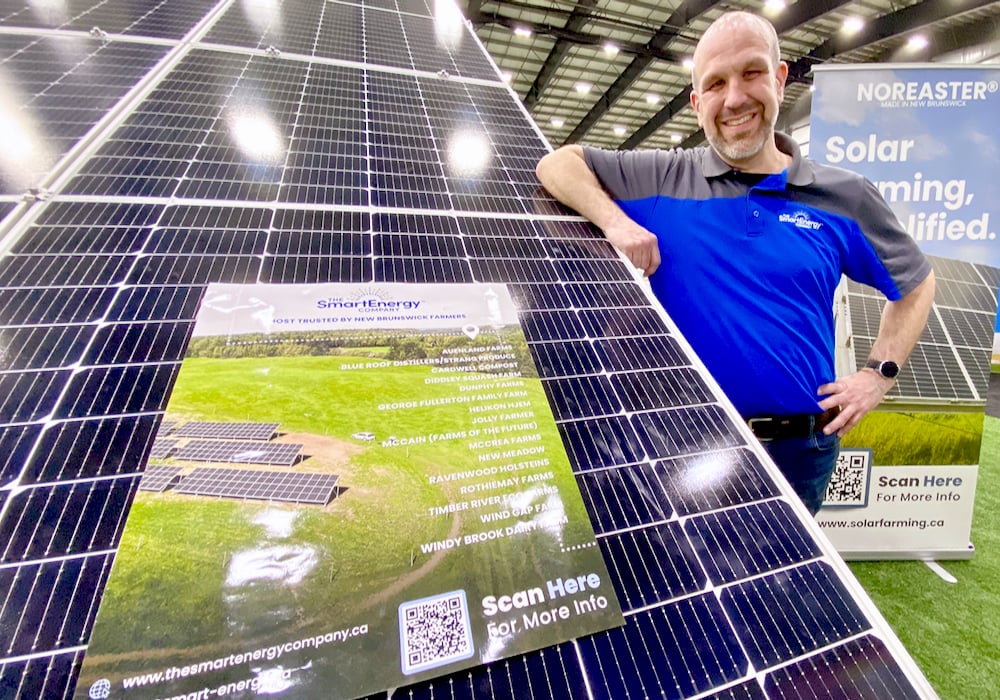Smart Energy Company brings the Noreaster solar solution to Ontario

A New Brunswick-based company is offering personalized micro-solar farm systems to Ontario farmers to help them lower on-farm electricity costs and bolster supply.
Read Also

Agriculture needs better frame for carbon value, says panel
Glacier FarmMedia – The agriculture industry can still get a hand on the reins of climate change discussions, said members…
“The cost of electricity is skyrocketing. It’s unpredictable. Farmers love finding unique solutions to help generate their independence,” said Jeff McAloon, Smart Energy co-owner. “And we help farmers generate independence.”
Why it matters: As energy costs continue rising and the electrical grid is under increased pressure, federal incentives for renewable energy projects make on-farm solar power more attractive.
McAloon’s brother Mark founded Smart Energy in 2016 with a vision to bring renewable energy-saving solutions to agriculture, industry, and rural operations that are facing rising electricity costs and compromised grid service.
At the end of the first year, the company transitioned away from other manufacturers’ high-maintenance solar panels to develop the Noreaster, a stackable system optimized for heavy snow loads and hurricane-force winds.
“With electrification and the aging grid across North America, utilities have no choice but to increase rates,” McAloon explained.
“We help farmers with a lot of different problems, but the top of the list is always their electricity bill. We’re helping get rid of that input cost or reducing it at the very least.”
New Brunswick’s low electricity costs don’t translate into the savings you’d find compared to Ontario, he said. Smart Energy has installed half of the province’s solar panels, which McAloon said speaks to the extra value their system provides.
One of Smart Energy’s early projects was installing a 170 solar farm for the New Brunswick Power Commission, which took a direct hit from Hurricane Fiona and came out unscathed.
“We anchor 50 per cent more than anybody, so there’s no part that’s going to vibrate,” he shared.
Noreaster’s modular adaptability allows operations to install one, five, 10 or more units immediately or over time to offset capital costs. In operations where regular outages occur, the Noreaster ties into a battery bank, providing livestock operations with uninterrupted power, he added.
McAloon spoke of a N.B. operation, Cardwell Farms Compost, which had initially installed two Noreasters. After a year, the seafood and cattle manure compost operation installed another one using Smart Energy’s DIY kit, which provided additional savings on a single unit’s approximately $25,000 capital costs.
“It’s the only commercial DIY kit available anywhere,” he said. “And now 50 per cent of our farmers do the DIY kit. On a small system, savings can be as much as $ 8,000 to $10,000.”
New Brunswick’s electricity rate will rise by 14 per cent in the next two years, Nova Scotia by 24 per cent and Ontario’s Hydro One jacked bills by 20 per cent on November 1, 2023, he said.
In Ontario, consumers using Time of Use (TOU) rates pay 8.7 to 18.2 cents/kWh or 10.3 to 12.5 cents/kWh on a tiered system. The 10kWh Noreaster costs five cents/kWh, providing significant savings even before federal incentives are applied, explained McAloon.
Smart Energy partnered with a local utility company early on to test the Noreaster’s energy production against six manual and automatic-style solar panel systems. The year-long study showed that Noreaster produced slightly less energy but cost significantly less in maintenance. It provided data for Smart Energy’s virtual calculating software, allowing clients to virtually build and test the Noreaster on their operation to see the savings.
“With the combination of our theoretical software and eight years of experience data, you can take it to the bank,” McAloon said. “If we say it’s going to produce this much energy, it’s going to produce this much energy.”
In addition to the 12-month analysis of the capital costs, savings, electricity output, carbon reduction and Noreaster energy production against traditional sources, Smart Energy’s financing partner calculates the federal tax incentives the project qualifies for.
“They structure the financing around your energy savings,” he said. “So, the farmer is cashflow positive from the very beginning.”
The federal government’s Clean Energy ITC, which applies corporate tax-paying operations, is a refundable tax credit covering up to 30 per cent of new clean technology costs until 2033. In 2034, the tax credit drops to 15 per cent.
“What I love about these programs is they’re becoming part of the tax code,” McAloon said, adding it also qualifies for an accelerated depreciation of 100 per cent of the capital costs in one year instead of over the asset’s life.
“Let’s say you have a $100,000 project, you’re going to get a $30,000 refundable tax credit,” McAloon explained. “If you only owe $10,000 in taxes, it will wipe that to zero, giving you the rest in a cash rebate. It’s tremendous. It’s a game changer for renewables in Canada.”
Source: Farmtario.com

